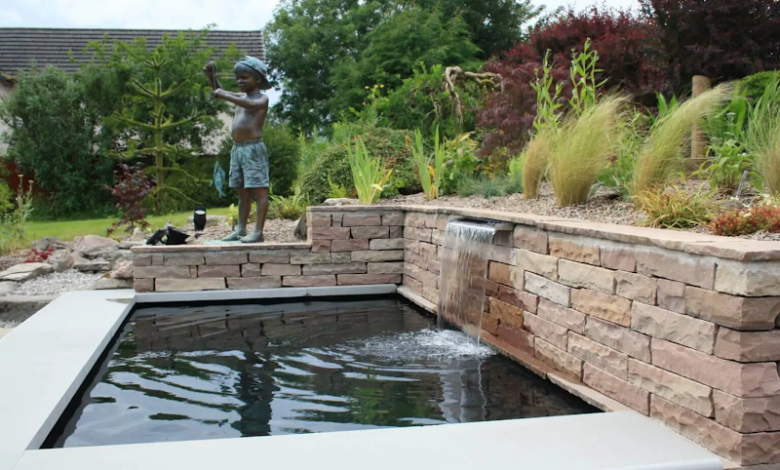Why Butyl Pond Liners Are the Key to a Long-Lasting UK Garden Pond

There’s something quietly magical about a garden pond. Perhaps it’s the gentle sound of water, the flash of a goldfish beneath the surface, or how dragonflies hover on a summer’s day. In Britain, ponds have long held a special place in the hearts of gardeners, not just as a decorative feature but as a symbol of tranquillity, biodiversity, and timeless charm.
From the formal water features of stately homes to the wildlife-friendly ponds tucked into suburban back gardens, ponds have become part of the landscape of British life. They’re places of reflection, literally and figuratively, where children spot frogs for the first time and adults steal moments of calm with a cuppa.
But behind the beauty lies something essential: a well-built pond begins not with water but with what holds it. And that’s where the right pond liner comes into play – especially in a climate as varied (and occasionally unforgiving) as ours.
Before we discuss why Butyl pond liners are trusted by UK gardeners worldwide, let’s examine what goes into creating a pond that lasts.
Under the Surface: What Most Pond Guides Forget to Tell You
After choosing the perfect spot and imagining how the pond will look, many people rush to the liner without considering what’s happening beneath it. But that’s often where problems begin.
Soil conditions across the UK vary more than most people expect. Some gardens have dry, crumbly earth, while others are filled with dense clay that holds onto moisture for far too long. Clay, in particular, can cause issues. It expands when wet and shrinks when dry, placing constant pressure on the liner. If the material cannot cope with this movement, it begins to stretch or crease, which weakens the structure over time.
Winter brings its challenges. When water in the soil freezes, it expands and shifts the ground slightly. This movement, known as frost heave, may not be apparent immediately but can slowly damage the liner from underneath. Over a few seasons, it can lead to sagging, folding, or even small tears.
Another factor people often overlook is the plants. Not just the ones you choose but the ones that find their way in. Many wild plants have strong roots that search for water wherever they can. Thin or low-quality liners can’t always stand up to that kind of pressure, and it’s only a matter of time before a tiny root causes a leak.
These hidden forces can slowly undo a pond that looks perfect on the surface. That’s why the choice of liner matters more than most people realise. It needs to handle movement, moisture, and time – all without letting you down.
Next, we’ll examine Butyl’s performance compared to other common liner materials and why it continues to be the preferred choice for many gardeners across the UK.
Butyl vs Other Pond Liners
With so many pond liner options available today, choosing the right one often comes down to understanding how each material performs over time – especially in the UK’s ever-changing weather. PVC, EPDM, HDPE, and Butyl all have their place in pond construction, and each brings something different to the table.
Many garden pond projects in the UK begin with PVC liners. Lightweight, flexible, and budget-friendly, PVC suits smaller or decorative ponds where ease of handling matters. It offers a practical solution for straightforward installs and remains popular for those starting.
EPDM liners
These liners have also gained a firm footing, especially in larger ponds or wildlife-friendly designs. Known for their flexibility and durability, EPDM liners adjust well to uneven surfaces. They can be a good fit for gardens that experience a lot of temperature variation throughout the year.
HDPE liners
These liners, on the other hand, are often used in more structured or commercial settings. Their strength and resistance to UV exposure make them suitable for long-term use, particularly in ponds with minimal shaping or complexity.
Butyl Pond Liners
For those who want a liner that blends strength with flexibility, Butyl continues to be a preferred option across many UK gardens. Its natural elasticity allows it to adapt to the subtle ground movements caused by rain, frost, and soil conditions without losing shape. That flexibility doesn’t come at the cost of toughness—butyl remains highly resistant to punctures and wear.
Another advantage lies in its long lifespan. Many Butyl-lined ponds installed decades ago are still in use today, quietly doing their job beneath the surface without needing attention. It’s a dependable choice for gardeners who prefer doing things once and correctly.
While each liner has its strengths, Butyl offers a reliable, long-term solution that stands up well to the UK’s mix of rain, frost, roots, and shifting soil. For those looking to build a pond that becomes a lasting part of the garden, Butyl provides peace of mind beneath the waterline.
The Quiet Strength of Butyl: More Than Just a Rubber Sheet
Not all pond liners are created equal, and Butyl has earned its reputation through consistent, long-term performance. Designed to cope with the varied conditions found across UK gardens, Butyl combines strength, flexibility, and safety in one dependable solution. Whether you’re building a wildlife pond or a formal water feature, Butyl provides the durability and reassurance that others simply cannot match.
- Butyl easily stretches, adapting to curves and contours without straining the material.
- It absorbs subtle ground movement, reducing the risk of stress points or damage over time.
- Butyl is entirely safe for fish, plants, and native pond life, such as frogs, toads, and newts.
- It contains no harmful additives, making it ideal for wildlife-friendly or ornamental ponds.
- The material resists UV exposure and will not crack or become brittle when exposed to sunlight.
- It maintains strength and flexibility even during dry spells, protecting your pond year-round.
- Butyl is widely recognised for its toughness and offers a more than 50 years working life.
- These genuine British-made Butyl liners come with a Lifetime Warranty for complete peace of mind.
- Once installed, you won’t need to replace the liner or worry about frequent repairs.
Pond Liner Pitfalls: Avoiding the Classic British DIY Blunders
Building a pond is a rewarding project, but it’s surprisingly easy to make avoidable mistakes. Here are some of the most common pitfalls we see and how you can steer clear of them.
Digging Too Deep, Too Soon
Over-excavating is a classic error. Going deeper than needed or cutting sharp sides makes it harder for the liner to sit correctly. It also increases the risk of slippage or stretching. Stick to gentle slopes and plan your shape before you pick up the spade.
Skipping the Underlay
This is one shortcut that rarely pays off. Laying a liner straight onto soil or stones may look fine initially, but hidden sharp objects or shifting ground can cause punctures over time. A quality underlay gives your liner the protection it needs and adds years to its life.
Choosing the Wrong Liner Thickness
Not all ponds need the same liner. Small decorative ponds may cope with thinner materials, but anything larger or deeper will benefit from a thicker, more robust option. Butyl liners offer long-term peace of mind with strength that handles ground movement and changing weather.
Rushing the Installation
Patience pays off. Creases, air pockets, or poor seam positioning can all lead to issues later. Take the time to smooth out the liner properly, check all edges, and let it settle before adding water.
Where the Smart Gardeners Shop: Trusted Butyl Suppliers in the UK
Regarding reliable, high-quality pond liners, UK gardeners are increasingly turning to Butek Ponds for their long-lasting, durable solutions. Whether you’re after a robust Butyl pond liner or a more budget-friendly alternative, you’ll find exactly what you need.
Why Gardeners Choose Butyl Pond Liners
- Premium Rubber Pond Liners
Butyl liners offer superior flexibility, UV resistance, and strength, making them the ideal choice for all garden ponds. They adapt seamlessly to various shapes and sizes, ensuring a secure and dependable fit. - Built to Last
Known for their toughness, Butyl pond liners can withstand the unpredictable British weather, resisting punctures, cracks, and fading over time. Designed for longevity, these liners provide lasting protection for your pond. - Options for Every Budget
Whether you’re looking to make a long-term investment or need a cost-effective option, there’s a Butyl liner to suit your needs. Their durability and reliability result in fewer replacements and repairs, saving you money in the long run.
For a dependable Butyl pond liner that delivers lasting quality and peace of mind, contact us today to discuss your requirements.
Conclusion
Building a durable pond requires more than choosing the right spot—it’s also about selecting the right materials. A quality Butyl pond liner ensures long-lasting durability, even in unpredictable UK weather. It prevents leaks, adapts to ground movement, and resists UV damage, making it an ideal choice for anyone looking to create a reliable, thriving water feature.
For those ready to invest in a pond liner that stands the test of time, Butek Ponds offers top-quality Butyl rubber liners designed to provide lasting protection and peace of mind. Contact their team today to discuss the best solution for your pond project.




